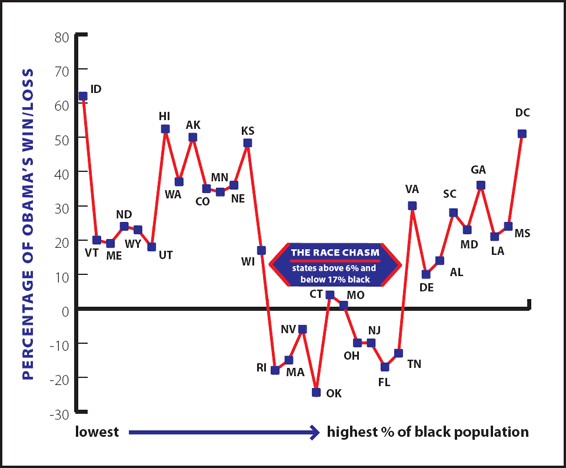I missed this fascinating article by David Sirota when it came out a couple of weeks ago, explaining why and how race matters in Hillary Clinton's primary campaign against Barrack Obama.

(View full size image.)
Since at least the South Carolina primary, the Clinton campaign’s message has been stripped of its poll-tested nuance and become a rather crass drumbeat aimed at reminding voters that Obama is black. Whether it is former President Clinton likening Obama’s campaign to Jesse Jackson’s; Clinton aides telling the Associated Press that Obama is “the black candidate,” or Geraldine Ferraro tapping into anti-affirmative action anger by claiming Obama’s success is a product of his skin color, barely a week goes by without a white Clinton surrogate injecting race into the nominating contest.
That is one of the twin pillars of the Clinton firewall—a well-honed strategy aimed at maximizing “the Race Chasm.” The Race Chasm may sound like a conventional discussion of the black-white divide, but it is one of the least-discussed geographic, demographic and political dynamics driving the contest between Clinton and Obama. I call it the Race Chasm because of what it looks like on a graph. Here’s how it works.
To date, 42 states and the District of Columbia have voted in primaries or caucuses. Factor out the two senators’ home states (Illinois, New York and Arkansas), the two states where Edwards was a major factor (New Hampshire and Iowa) and the one state where only Clinton was on the ballot (Michigan) and you are left with 37 elections where the head-to-head Clinton-Obama matchup has been most clear. Subtract the Latino factor (a hugely important but wholly separate influence on the election) by removing the four states whose Hispanic population is over 25 percent (California, New Mexico, Texas and Arizona), and you are left with 33 elections that best represent how the black-white split has impacted the campaign.
As the Race Chasm graph shows, when you chart Obama’s margin of victory or defeat against the percentage of African-Americans living in that state, a striking U trend emerges. That precipitous dip in Obama’s performance in states with a big-but-not-huge African-American population is the Race Chasm—and that chasm is no coincidence.
On the left of the graph, among the states with the smallest black population, Obama has destroyed Clinton. With the candidates differing little on issues, this trend is likely due, in part, to the fact that black-white racial politics are all but non-existent in nearly totally white states. Thus, Clinton has fewer built-in advantages. Though some of these states like Idaho or Wyoming have reputations for intolerance thanks to the occasional militia headlines, black-white interaction in these places is not a part of people’s daily lives, nor their political decisions. Put another way, the dialect of racism—the hints of the Ferraro comment and codes of Bill Clinton’s Jesse Jackson reference, for instance—is not politically effective because such language has not historically been a significant part of the local political discussion. That’s especially true in the liberal-skewed Democratic primary.
On the right of the graph among the states with the largest black populations, Obama has also crushed Clinton. Unlike the super-white states, these states—many in the Deep South—have a long and sordid history of day-to-day, black-white racial politics, with Richard Nixon famously pioneering Republican’s “southern strategy” to maximize the racist segregationist vote in general elections. “But in the Democratic primary the black vote is so huge [in these states], it can overwhelm the white vote,” says Thomas Schaller, a political science professor at the University of Maryland—Baltimore. That black vote has gone primarily to Obama, helping him win these states by big margins.
It is in the chasm where Clinton has consistently defeated Obama. These are geographically diverse states from Ohio to Oklahoma to Massachusetts where racial politics is very much a part of the political culture, but where the black vote is too small to offset a white vote racially motivated by the Clinton campaign’s coded messages and tactics. The chasm exists in the cluster of states whose population is above 6 percent and below 17 percent black, and Clinton has won most of them by beating Obama handily among white working-class voters.
In sum, Obama has only been able to eke out victories in three states with Race Chasm demographics, where African-American populations make up more than 6 percent but less than 17 percent of the total population. And those three states provided him extra advantages: He won Illinois, his home state; Missouri, an Illinois border state; and Connecticut, a state whose Democratic electorate just two years before supported Ned Lamont’s insurgent candidacy against Joe Lieberman, and therefore had uniquely developed infrastructure and political cultures inclined to support an outsider candidacy. Meanwhile, three-quarters of all the states Clinton has won are those with Race Chasm demographics.
Pennsylvania Gov. Ed Rendell (D), a Clinton supporter, publicly acknowledged this dynamic in February. He suggested to the Pittsburgh Post-Gazette editorial board that Obama’s ethnicity could prevent him from winning the state, which, at 10.6 percent black, falls squarely in the Race Chasm.
“You’ve got conservative whites here, and I think there are some whites who are probably not ready to vote for an African-American candidate,” Rendell said.
That was echoed by Obama supporter David K. Levdansky, a state representative from western Pennsylvania. “For all our wanting to believe that race is less of an issue than ever before, the reality of racism still exists,” he told the New York Times. “It’s not that [Pennsylvanians] don’t think he’s qualified, but some people fear that it might be empowering the black community by electing Obama.”
Read the whole thing.







